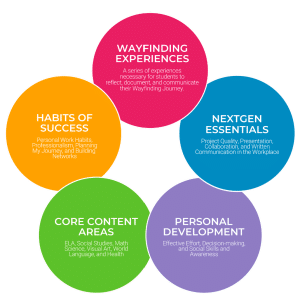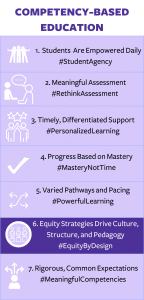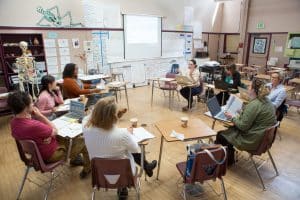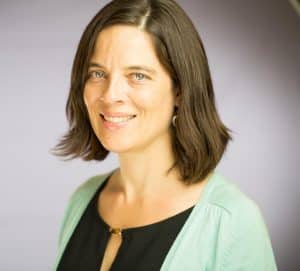Reflections from the 2023 Competency-Based Education Field Coordination Call
CompetencyWorks Blog
In late May, CompetencyWorks held a Competency-Based Education (CBE) field coordination Zoom call with over 50 representatives from organizations supporting CBE in their work. The call, which happens every one to two years, provides a space for people in the field of CBE to share our work and make connections to help identify ways to coordinate and avoid duplication. In preparation for the call, over 40 organizations contributed to a collaborative document with their updates and observations about the challenges or emerging issues they are seeing in supporting CBE practice and systems change. This post highlights a few of the themes that emerged as a way of sharing with the broader field including rethinking the Carnegie unit, centering equity, supporting teachers, and the importance of leadership in the change process.
Rethinking the Carnegie Unit
One theme in the work across organizations is replacing obsolete infrastructure in our education system, building consensus on what we need to do instead, and helping to chart a path to new practices and policies. The “Carnegie unit,” based on seat-time or time in a classroom, anchors our predominant time-based system in place. A key area of CBE enabling policy is shifting from seat time to competency-based credit.
The Carnegie Foundation itself, which originally created the Carnegie unit in 1906, is participating in the conversation to rethink the Carnegie unit for a new system that aligns with the knowledge, skills, and dispositions learners need in order to thrive in a changing world. They have also partnered with ETS (Education Testing Service) to rethink assessment systems. How can we dismantle the current structure, which was created in the past for a different time and purpose, to fit the needs of students today?

Building 21’s competency portfolio offers one approach to how we design competency-based credits. Through a range of learning experiences, often driven by the learners themselves, Building 21 students curate a body of evidence to demonstrate their learning of a set of competencies that includes academics and a broader set of habits and transferable skills. This can be done not only inside the classroom, but outside of the classroom as well. After-school activities, community volunteering and experiences, family trips, and more could also provide evidence of competence. It is important to foster learning outside of the classroom. Their competency portfolio approach allows students to look at the competencies, see their areas of strength and growth, and find different ways to demonstrate proficiency. In the process, students create a portfolio of academic skill sets and knowledge while also increasing their ability to advocate for themselves and set goals.
Beyond academics, other essential skills and dispositions can be developed and documented more effectively with competency-based approaches. New Generation Learning Challenges shared their new resource with tools and stories from five districts that created and used a Portrait of a Graduate to empower educators and communities to think about what kind of student they want to graduate from their school. Graduate portraits (or profiles) typically include skills like creativity, critical thinking, collaborating, becoming a life-long learner, and being self directed. Beyond getting a certain score on a test or taking a certain amount of advanced classes, these essential skills and dispositions will benefit students in their lives regardless of their post-secondary plans.
Participants also discussed the shift in the learning culture required for CBE: how can we convince students that learning beyond test scores, grades, and pure academics is valuable? The pandemic has had a significant impact on students. Too many students are disengaged and communities are divided about what to do about it. Portrait of a Graduate work is collaborative, engaged, community-organized work to understand how we can best prepare students to be members of our community. Graduate portraits and student-driven, competency-based pathways have the potential to unite and re-energize people around a new era of innovation and transformation.
Working Actively Toward Educational Equity
A central driving force of CBE is working actively toward educational equity as we pursue  competency-based, student-centered approaches. Integrating culturally responsive practices into CBE embodies the spirit and driving purpose of CBE as a student-centered systems approach to designing for equity. A leading example is the Washington Mastery-Based Learning Collaborative, supported by the New Learning Collaborative and the Great Schools Partnership, which explicitly brings CBE and culturally responsive-sustaining education together in its CBE pilot work. Efforts to advance equity guides the professional learning community of over 20 grantee schools across Washington state.
competency-based, student-centered approaches. Integrating culturally responsive practices into CBE embodies the spirit and driving purpose of CBE as a student-centered systems approach to designing for equity. A leading example is the Washington Mastery-Based Learning Collaborative, supported by the New Learning Collaborative and the Great Schools Partnership, which explicitly brings CBE and culturally responsive-sustaining education together in its CBE pilot work. Efforts to advance equity guides the professional learning community of over 20 grantee schools across Washington state.
Another big question many organizations are reflecting on relates to a different dimension of equity: how can we achieve racial equity when the CBE field (and the educator workforce more broadly) is predominantly white? The Great Schools Partnership is one organization working on the issue of diversifying the educator workforce. It is important to approach diversifying educator pipelines through multiple perspectives and angles; one hiring initiative isn’t going to fix barriers currently upheld by an unjust system. Cultivating educator workforce diversity requires sustained work on recruitment and in creating welcoming workplaces where people can thrive. Much of the work is local, though it is helpful to learn from other states, schools, and individuals.
Shawn Rubin and Malika Ali from the Highlander Institute spoke about their Community Educator Network initiative as an example of a community-driven solution that supports student learning and entry points into the educator profession. The program trains local community members to support students both inside and outside of school. Recruiting community members into schools can have a multitude of benefits, including leveraging community knowledge to build deeper engagement in schools and creating new roles and pathways for full-time school employment. Rubin and Ali spoke specifically to an example at Central Falls High School in Rhode Island, in which they worked with a second organization, Freedom Dreams, to design curriculum around the needs of students and families by creating “pods” of students working with a community mentor. In addition to creating new roles to add staffing capacity, students gained a deeper sense of trust and belonging emerged in the learning environment, as well as improvements in academic and social performance.
Supporting Educators
In the wake of the pandemic, the theme of educator fatigue and exhaustion emerged as a pressing challenge. Even if they are willing, many teachers don’t have the needed time to engage in deeper professional learning and sustain learned practices. One solution to this is rethinking the design of educator roles to be sustainable while also allowing space for educators to heal. During the 2023 field coordination call, we went into breakout rooms where CBE leaders discussed this topic.

In CBE specifically, especially for educators newer to CBE, teachers will be learning how to create a thriving learner-centered environment. CBE leaders and support organizations can think about ways to support educators by allowing more educator flexibility and using professional development to share great tools teachers are already implementing on their own. Taking a top down approach could lead to pushback or a misunderstanding of CBE by teachers. Instead, models like the Massachusetts-based Teacher Collaborative include teachers in deeper learning and invite teachers to be agents of change which leads to more effective professional development. One-size-fits-all professional-development opportunities are not aligned to the ideas of CBE and can make it hard for teachers to see how their time is being valued. When professional learning is meaningful it can ignite educators’ original passion for the profession and be both part of the solution to healing fatigue and engaging educators as partners in transformation to CBE practices.
Leading Change
Leading change to enable transformation requires leadership capacity, resources and funding, and the ability to design and implement new systems and practices. Sustained change requires intentionality, commitment, and time with strong leadership and inclusive change processes. As Devin Vodicka from Learner Centered Collaborative said, “this is not like a thirty minute workshop where all of a sudden people are transformed.” Nik Namba from Transcend added that truly learner-centered leaders often walk a lonely road as they face hesitation from fellow administrators as well as district and state leaders. With the help of like-minded leaders and organizations, learner-centered leaders can find the community around which systems can be, “built, rebuilt, or completely reimagined.” This is essential, agreed Andy Calkins of New Generation Learning, also recognizing that leadership change starts through catalyzing rather than trying to follow a linear process or a checklist.
A related issue is finding reliable and sustained funding for innovation in education. The education system has had an influx of money through the ESSER (Elementary and Secondary School Emergency Relief Fund) bills to support education during and after the pandemic. However, it can be challenging to leverage that funding to benefit learners during an emergency and invest it in ways that can be sustained when those funds are no longer available. Navigating funding can also be time-consuming when funder strategies shift and systems must decide how to align to their vision. While funding can accelerate innovation, because of its uncertainty, transformational approaches like CBE benefit from being a grassroots initiative that builds a committed community willing to rethink how they allocate education funding.
Communicating the value of CBE to the community, funders, and educators generates the needed resources to build momentum. For example, projects that support young people in making real world connections and applying their learning in the workforce can generate excitement for work-based learning programs such as internships, apprenticeships, and career pathways. Transferable competencies prepare students for their future careers and learning.
Connection and Dialogue Inspires
As we closed the session, several participants expressed gratitude for having the space to connect with others in our field. Despite the long arc of change and the recurring and emerging challenges participants find themselves navigating with their school, district, state, and community partners, we left with a feeling that the dialogue sparked renewed hope for many. At CompetencyWorks, we can’t wait to continue the conversations and develop ideas for future-focused action. We feel honored to play a role in creating spaces for connection and convening.
 Laurie Gagnon joined the Aurora Institute in 2022 and the day of the field coordination call was also the day of her one year anniversary in her role as the CompetencyWorks Program Director. She leads the work of sharing promising practices shaping the future of K-12 personalized, competency-based education (CBE). Her work includes identifying trends; conducting and facilitating research to answer critical questions facing the field; and disseminating those findings widely. Laurie began her professional life teaching English in Japan and high school history in the U.S. She lives in Somerville, MA with her partner, young son, and cat.
Laurie Gagnon joined the Aurora Institute in 2022 and the day of the field coordination call was also the day of her one year anniversary in her role as the CompetencyWorks Program Director. She leads the work of sharing promising practices shaping the future of K-12 personalized, competency-based education (CBE). Her work includes identifying trends; conducting and facilitating research to answer critical questions facing the field; and disseminating those findings widely. Laurie began her professional life teaching English in Japan and high school history in the U.S. She lives in Somerville, MA with her partner, young son, and cat.
 Briana Medina joined the Aurora Institute in May 2023 as a CompetencyWorks intern. She is a junior at the University of Wisconsin-Madison studying Political Science and Education Studies. She is committed to educational equity and is passionate about its relation to competency-based learning.
Briana Medina joined the Aurora Institute in May 2023 as a CompetencyWorks intern. She is a junior at the University of Wisconsin-Madison studying Political Science and Education Studies. She is committed to educational equity and is passionate about its relation to competency-based learning.
She currently serves on the UW-Madison College of Letters and Science Curriculum Committee, where she reviews and recommends course and program additions, revisions, and policies relating to academic offerings. In the past, Briana has worked as an intern at Kettle Moraine School for Arts and Performance, giving tours and teaching in a competency-based learning environment. Additionally, she worked with the Institute for Personalized Learning on panel discussions, high-level presentations, and blog posts.
 Alyssa Weaver is the Policy Research Intern at Aurora Institute’s CompetencyWorks program. She recently completed her second masters degree in public policy at the University of Chicago, where she focused on education policy. She was a board member of the Education Policy Student Association and a production assistant for Pencils Down, the University of Chicago Public Policy Podcast’s show about education policy. She was a former teacher of seven years and taught informal science education, preschool, and most recently, 5th-grade math. She has spoken at conferences and schools on COVID-19 learning loss, project-based learning, multidisciplinary STEM integration, and green spaces for equity. She was recently published on Bored Teachers about the ethical use of A.I. in the classroom, on Medium’s Educate about the integration of school green spaces, and on Medium’s Chicago Education Advocacy Cooperative about deeply understanding school equity.
Alyssa Weaver is the Policy Research Intern at Aurora Institute’s CompetencyWorks program. She recently completed her second masters degree in public policy at the University of Chicago, where she focused on education policy. She was a board member of the Education Policy Student Association and a production assistant for Pencils Down, the University of Chicago Public Policy Podcast’s show about education policy. She was a former teacher of seven years and taught informal science education, preschool, and most recently, 5th-grade math. She has spoken at conferences and schools on COVID-19 learning loss, project-based learning, multidisciplinary STEM integration, and green spaces for equity. She was recently published on Bored Teachers about the ethical use of A.I. in the classroom, on Medium’s Educate about the integration of school green spaces, and on Medium’s Chicago Education Advocacy Cooperative about deeply understanding school equity.
